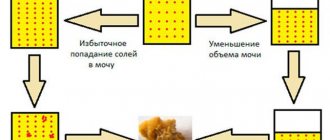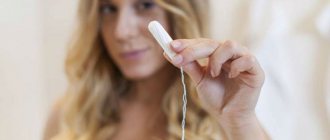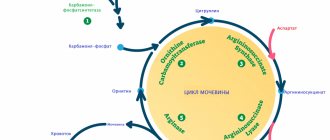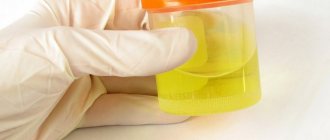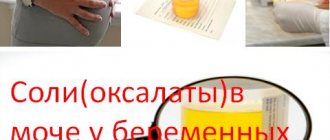A change in the characteristics of a person’s urine is a reason to consult a urologist and conduct a detailed diagnosis. Specialists of the SANMEDEXPERT clinic always help patients in solving such problems.
Urine is a product of filtration of human blood by the kidneys. It contains substances and metabolites that must be eliminated from the body. It is by changing urine parameters that doctors can diagnose diseases and pathological processes.
The color of urine depends on the impurities in its composition. These are mainly uropigments (products of the breakdown of hemoglobin) and uric acid salts, which are in dissolved form. Depending on the content of impurities, urine changes color from faint yellow to straw and deep yellow. If there is polyuria (increased urination), which can be caused by both pathology and heavy drinking, for example in the heat, the kidneys do not have time to increase the density of urine due to absorption, so it becomes lighter.
A change in the color of urine can immediately lead the doctor to believe that the patient has a specific pathology. Identification of other symptoms of the disease, as well as laboratory testing of urine, usually puts an end to the diagnosis of the cause of the changed color.
Reception is strictly by appointment only!!!
Doctor Plus LLC License No. LO-77-01-004801
Registration at the clinic by phone
Make an appointment at the clinic
- +7 (495) 125-49-50
- Addresses of clinics in Moscow
- Daily
- call me back
Acetone in urine
- this phrase means the identification of ketone compounds in the test results. Ketones are the result of metabolic processes in the liver. In a healthy person, they are present in such small quantities that they do not affect the results of laboratory tests of urine. With impaired metabolism, the synthesis of ketone compounds in the liver increases, which leads to the occurrence of diseases.
Ketone compounds include acetoacetic acid, acetone, and beta-hydroxybutyric acid. Initially, their appearance and increase in concentration begins in the blood, and, as a result, in the urine. If an unpleasant odor appears during urination, and a specific taste of acetone appears in the mouth and breath, then this is a cause for concern.
Urine examination using dry chemistry method
a:2:{s:4:"TEXT";s:14677:" In clinical laboratory practice, multicomponent (multifunctional) test strips have become widespread for studying the physicochemical properties of urine. Using such test systems, it is possible not only to assess the chemical composition, but also to determine such parameters as color, turbidity and the presence of pathological cellular elements in the urine.
The use of multicomponent test strips makes it possible to reduce the number of samples for microscopic examination, since at the stage of urine testing using dry chemistry, “healthy” samples are eliminated, and only material with positive results according to one of the parameters of the test system is subjected to microscopic examination. In addition, the use of test strips makes it possible to identify cellular elements that have undergone lysis (erythrocytes, leukocytes), which significantly increases the accuracy of the study and, accordingly, timely diagnosis of the pathological process.
When assessing the components of urinary sediment with test strips, it should be taken into account that the system does not determine the cellular elements themselves, but biochemical parameters that have a high correlation coefficient with them. Thus, the presence of erythrocytes will be indicated by a positive hemoglobin test, leukocytes - by a positive esterase test.
Preparation of urine samples for analysis using test strips using the dry chemistry method:
- Urine should be at room temperature. If the urine container was stored in the refrigerator, the sample must be brought to room temperature before testing.
- The container with urine should not be exposed to temperatures above 30 0C and direct sunlight.
- Urine samples containing food or medicinal dyes should be excluded.
- For testing, use fresh, UNCENTRIFUGED urine.
An important factor influencing the results of a dry chemistry test is the time that passes from the moment of urine collection to the start of the study in the laboratory.
Changes that occur in urine over time after collection:
- Decreased transparency due to crystallization of substances dissolved in the urine.
- Increased pH due to ammonia released into the urine by bacteria.
- Decrease in the concentration of ketone bodies and glucose.
- Destruction of bilirubin.
- Lysis of red blood cells and other cellular elements.
- Contamination of the material with foreign bacterial flora.
The sensitivity of test strips for urine testing using dry chemistry, as well as the color of the indicator, will depend on the reagent composition of each zone, which will differ depending on the manufacturer.
The main clinically significant parameters that can be obtained by examining urine using the dry chemistry method are:
- PHYSICAL PARAMETERS – specific gravity, pH
- CHEMICAL PARAMETERS – urobilinogen, bilirubin, glucose, protein, ketone bodies, ascorbic acid.
- CELLULAR COMPOSITION – blood (erythrocytes), leukocytes, bacteria (nitrites).
Performing a urine test using test strips:
- Mix the biological fluid to be tested well (without shaking) by turning the container over.
- Take as many strips from the tube as needed for immediate use and immediately close the tube tightly with the factory cap with desiccant.
- Immerse the strip in the test solution for 1-2 seconds so that all test areas are wetted.
- Remove excess liquid from the strip by rubbing the edge of the strip against the edge of the container. Leave the strip horizontally on the filter paper.
- After the required time has elapsed, assess the change in color of the zones of the strip visually, comparing with the reference scale on the packaging.
- Comparison of color changes in the test zones of the strip, with the exception of the leukocyte zone, is carried out within 1-2 minutes; changes in the color of the indicator after 2 minutes have no diagnostic value.
Fig.1. The procedure for examining urine with test strips using the dry chemistry method.
When interpreting the results of testing urine samples, it is necessary to take into account the possible influence on the analytical abilities of the reagent zones of test strips of various factors leading to false positive/false negative results.
The most common reasons affecting the results of the study:
Specific gravity
High concentrations of ascorbic acid (higher than 700 mg/l) may cause the zone color to shift to lower specific gravity values. Urine pH values higher than 6.5 shift the coloration of the zone to lower specific gravity values. Urine pH values lower than 6.0 shift the coloration of the zone to higher specific gravity values.
Nitrites
A negative result does not exclude bacteriuria and may indicate infection with bacteria that do not contain nitrate reductase (Streptococcus, Neisseria gonorrhoeae, Staphylococcus, Mycobacterium tuberculosis, Enterococcus).
The sensitivity of this test is reduced if:
- Examination of urine with high specific gravity.
- High concentration of ascorbic acid (400 mg/l or more).
- A small amount of nitrite ions (1.0 mg/l or less) in the urine.
pH
Prolonged standing of urine causes the urine pH to shift to higher values due to ammonia released into the urine by bacteria.
During the testing procedure, the test strip must be immersed in urine for a certain time, since if immersed for too long, the pH of urine tends to decrease (acidify).
Ketone bodies
Medicinal and diagnostic preparations based on phenolphthalein or sulfonephthalein present in the urine may turn red or even purple in the alkaline environment of the zone.
False underestimation of results can occur when urine is stored for a long time in an open container due to the evaporation of acetone.
Glucose
The minimum amount of glucose that can be excreted by the kidneys normally (physiological glycosuria) colors the diagnostic zone in a greenish tint, which is sometimes labeled “normal” on the label.
Protein/albumin
False-positive results can be obtained from the urine of patients taking quinine drugs or drugs based on quinoline derivatives. False-positive results may be associated with the use of insufficiently clean urine collection containers containing traces of disinfectants and detergents, especially those based on quaternary ammonium salts. Nonionic or anionic detergents may cause low or false negative results.
In highly alkaline urine (pH higher) or in urine with exceptionally high buffer capacity, the test may give false positive results.
or in urine with exceptionally high buffer capacity, the test may give false positive results.
Leukocytes
The color intensity of the indication zone increases with a highly alkaline reaction of urine and an increased relative density of urine. Determination is hampered by the strong color of urine with an increased content of bilirubin and other chromogens.
Bilirubin/Urobilinogen
The tested urine should be protected from direct sunlight, which promotes the oxidation of bilirubin, leading to an underestimation or negative result.
Urobilinogen in concentrations above 100 µmol/l interferes with the determination of bilirubin. Substances that are red or acquire a red color under the influence of the acidic environment of the reaction zone (for example, phenazopyridine) also interfere.
Red blood cells/hemoglobin
Urine that is heavily contaminated with certain bacteria, yeast, or mold may test positive;
containing high concentrations of ascorbic acid (vitamin C) or drug-derived inhibitors. ";s:4:"TYPE";s:4:"HTML";}
Causes
One of the main components of metabolism is glucose, through the breakdown of which cells receive nutrition and energy. With insufficient glucose intake, the body begins to synthesize it from fat reserves, accompanied by the formation of ketone compounds, which are, in fact, industrial waste that must be removed in a timely manner. And with an excessive amount of glucose, the concentration of acetone increases as a result of its excess. Initially, the level of ketones increases in the blood, then begins to increase in the urine.
The reasons may be:
- prolonged fasting or unbalanced diet;
- heavy physical activity;
- food overloaded with proteins and fats;
- diabetes;
- inflammatory and infectious diseases.
Like many other metabolic disorders in the body, acetone in the urine
may be a symptom of a possible serious illness. A gradual increase in ketone concentration occurs over several days, and in children this condition develops within a few hours. In the event that acetone in the urine is an episodic, one-time phenomenon, it may be enough to change the diet to a more balanced one in the direction of reducing the consumption of fatty protein foods.
You can make an appointment with a venereologist from our consultants by calling +7 (495) 125-49-50
Prices for venereologist services Addresses of clinics Pain during urination Itching of the vulva Ultrasound of the prostate Calling a venereologist to your home
Cloudy urine in a child
Urine (urine) is one of several biological fluids in our body, the appearance of which can change both in a healthy state and during the development of a disease. Let's look at a few characteristics of a child's urine to help you figure out when to sound the alarm and when to watch.
Normally, urine is a clear liquid ranging from light straw-colored (in very young children the straw-colored color can be very pale, almost like water) to deep yellow. I would like to note that in infants in the first 1-2 weeks of life, the color of urine may change to orange or reddish. This is due to increased excretion of uric acid in the urine and is a variant of the norm if the child is in normal health.
Impaired urine clarity is not always a cause for alarm if : - Your child drinks little water or very hot weather conditions, very intense physical activity (there is still a danger of dehydration!); — The baby takes some medications, vitamins, dietary supplements; — He likes to drink or eat fermented milk or meat products, as well as some vegetables and fruits at night.
Mom may also be alarmed by cloudy urine if it is left in a pot or jar for a long time. The components of urine come into contact with oxygen in the air, as a result we see that the transparency of the urine has disappeared. Also, during puberty in girls, specific physiological secretions (leucorrhoea) can cause cloudy urine.
“Red flags” are alarming symptoms that require mandatory examination by a specialist - a nephrologist:
- Constantly cloudy urine. One of the reasons may be persistent crystalluria (phosphaturia, uraturia, oxalaturia, cystinuria) or “salts” in the urine; — Change in its smell (sweetish, fishy smell, acetone smell, etc.). Often, along with a change in smell, mothers note that such cloudy urine acquires a gel-like consistency and has flaky inclusions; — Changes in the child’s well-being, the appearance of fever, unexplained vomiting, pain in the abdomen, lower back, changes in the frequency of urination, discomfort when urinating, absence of urination for more than 3 hours during daylight hours, the appearance of swelling on the face that does not go away in the afternoon , as well as swelling in other parts of the body (legs, arms, abdomen, external genital area). When the legs swell, in particular, mothers notice that marks from socks on the legs remain for a long time or do not go away at all, panties, shoes, boots or other shoes suddenly become small, and the child has gained a lot of weight in a matter of days. - Change in the color of urine (black, red or the color of “meat slop”, the color of tea or beer, the color of pomegranate juice, raspberry urine) - Constantly foaming urine, looks like the white of a chicken egg; — Persistence of enuresis (bedwetting) in children over 5 years of age, especially if this symptom is accompanied by periods of fever without signs of acute respiratory viral infection.
Alarming symptoms may be a manifestation of : - Dehydration; — Metabolic diseases (metabolic nephropathies, including urolithiasis); — Diabetes mellitus; — Inflammatory diseases of the urinary system and external genitalia (cystitis, pyelonephritis, vesicoureteral reflux, vulvitis, balanitis); - Glomerulonephritis; — Tubulo-interstitial nephritis; — Blood pathologies, for example hemolytic conditions, blood clotting disorders; — Poisoning by medicinal, chemical, natural substances; — Liver diseases; - Some congenital diseases that may be accompanied by kidney damage.
Detection of symptoms—“red flags”—requires consultation with a nephrologist to clarify the cause and provide timely assistance if necessary.
Symptoms of acetonuria in adults and children
With an increase in the intake of acetone in the urine, the symptoms increase gradually, starting with general ones, the appearance of which is considered a mild malaise or with signs of fatigue or food poisoning. If measures to eliminate the causes are not taken in time, the symptoms become more pronounced and the malaise becomes stronger.
The symptoms are listed below in ascending order:
- lethargy, drowsiness;
- frequent or constant headache;
- nausea and vomiting;
- pain in the epigastric region;
- the smell of acetone in body secretions (urine, saliva);
- temperature increase.
In children, the main symptom of acetonuria is profuse vomiting with a strong characteristic odor. In this case, urgent hospitalization in a hospital is necessary, where the child will receive the necessary medical care, tests and treatment will be prescribed.
The greatest danger of sudden development of acetonuria, even in practically healthy children, is the consumption of chips and crackers. It is no coincidence that doctors categorically do not recommend giving such products to children.
Change in urine color due to medication
Some drugs are excreted from the body by the kidneys along with urine. Some of them are capable of changing its normal color:
- a red color may occur when taking the antibiotic rifampicin, antipyretics - amidopyrine and antipyrine, as well as the laxative purgen, which contains phenolphthalein;
- Pink color of urine can be caused by long-term use of high doses of acetylsalicylic acid (aspirin);
- a dark brown color may occur during treatment with phenyl salicylate;
- the blue-green color is caused by triamterene, which is used to enhance renal blood flow;
- Orange urine color occurs when taking the vitamin riboflavin.
Diagnosis and treatment
At home, you can conduct a rapid test for elevated levels of acetone in the urine. Pharmacies sell special test strips that give results within a few minutes. This test must be carried out in the morning for 3 days. If, as a result of a rapid test, a person has an increased level of ketones in their urine, they should immediately consult a doctor.
Doctor, therapist or urologist
, prescribes the necessary tests and studies, based on the results of which a treatment regimen is determined. If test results and ultrasound show serious excesses of the norm for acetone in the urine, the patient needs a more complete examination and treatment in a hospital.
In our clinic, patients are provided with a full range of medical services using the most modern equipment, using the latest technologies and innovations existing in medicine.
| Brief price list for tests | |
| Calling a nurse to your home | 1500 rubles |
| Doctor's appointment at the clinic | 900 rubles |
| Collection of biomaterial | 200 rubles |
| Intramuscular injections | 200 rubles |
| Blood tests for hCG | 600 rubles |
This article does not constitute medical advice and should not serve as a substitute for consultation with a physician.
general information
It is simply impossible to understand what exactly causes such symptoms without conducting an examination, at least a basic general urine test. The appearance of jelly-like, thick urine can be caused by various factors, from the presence of protein in urine to pyuria, that is, purulent urine.
In addition, it is necessary to know the patient’s condition, his complaints and the presence of chronic or past diseases (history of life, illness). Any changes in urine characteristics are not the disease itself, but only one of the symptoms of a developing pathology. Therefore, if urine thick as jelly appears, it is urgent to visit a medical facility. Reception according to the following symptoms is carried out:
- urologist;
- nephrologist;
- therapist.
The listed specialists will prescribe the necessary examination and proper treatment. Self-medication in such a situation is very dangerous and can lead to irreparable consequences.
Treatment with diet No. 14
The essence of the diet is to reduce the consumption of foods that contain calcium and have an alkalizing effect, and increase the amount of those that oxidize the body.
If you have phosphaturia, you should completely exclude the following from your diet:
- fatty fish and meats;
- milk soups;
- pickles;
- smoked meats;
- spices;
- baked goods;
- cocoa and chocolate;
- alcohol.
Drinking strong tea and coffee is not recommended, as they irritate the kidneys. The consumption of all dairy products, egg yolks, peanuts, mushrooms, potatoes and other vegetables is significantly limited. The basis of the diet is meat, poultry and fish, prepared in any way, and various cereals. Healthy dishes include seafood, green peas, Brussels sprouts, pumpkins, as well as sour apples, sauerkraut, cranberries and lingonberries. Meals should be fractional. Bread – dried, made from wholemeal flour. Refractory fats are prohibited.
There is no need to eat very dry food. So that the urine is not concentrated and salts are not detected in it, you need to drink as much liquid as possible, in the absence of restrictions - up to 2.5 liters per day: bread kvass, fruit drink, jelly. For phosphaturia, it is useful to drink a glass of slightly alkaline non-carbonated mineral water on an empty stomach.
Since the diet of diet No. 14 is not meager, it can be practiced for as long as treatment requires, and it is advisable to take vitamin complexes (A, B, D2). Urinalysis should be done periodically to check the salt concentration.
